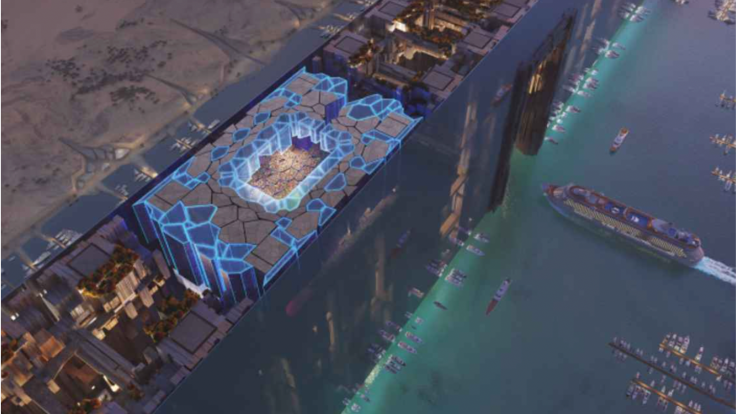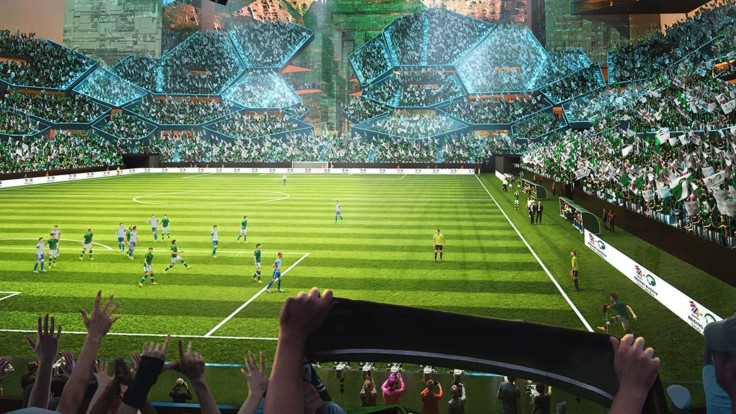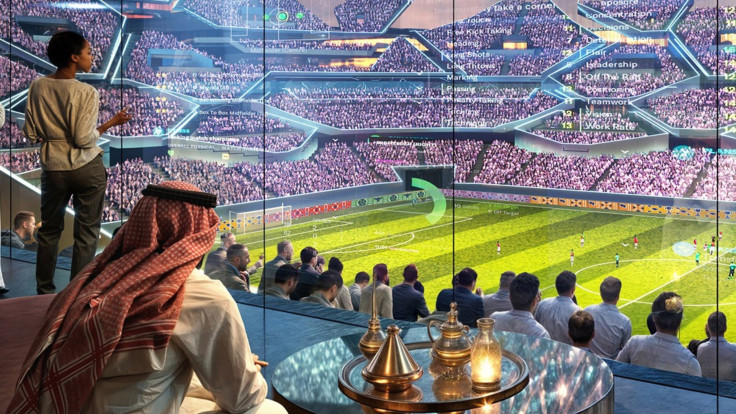Football Fans Stunned by Saudi Arabia's 1,000ft-High 2034 World Cup Venue — But Is It Real or an AI Hoax?
Viral footage sparks debate over Saudi's real 46,000-seat stadium, part of the 2034 World Cup infrastructure plan.

A viral video depicting a football stadium perched atop a gleaming skyscraper has captured social media users' attention this week, igniting both awe and scepticism about Saudi Arabia's ambitious plans for the 2034 World Cup. The short clip shows a luminous, bowl-shaped arena seemingly floating above a futuristic cityscape, with sweeping glass façades and sky-bridges connecting to neighbouring towers. Within hours, the images had ricocheted across platforms, amassing millions of views and raising questions: Is this real? Could it be safe?
The answer is a complex blend of fact and fiction.
Fact and Fiction Intertwined
The video, believed to be AI-generated by an internet user known as 'Artology,' depicts a glowing structure towering over a futuristic skyline. However, the core concept is genuine, even if the viral imagery is exaggerated.
Saudi Arabia has unveiled plans for the NEOM Sky Stadium, a revolutionary 46,000-seat arena designed to be suspended 1,150 feet (350 metres) above the ground, integrated into the roof of its ultra-modern megacity, The Line. Announced as a key feature of the Kingdom's bid for the 2034 FIFA World Cup, the stadium is slated for completion by 2032.
🚨 Saudi Arabia is set to construct the world's first "sky stadium”. 🏟️
— Transfer News Live (@DeadlineDayLive) October 27, 2025
It will be suspended 1,150 feet above the ground, the venue is expected to open around 2032 and will host matches for the 2034 FIFA World Cup. 🇸🇦
pic.twitter.com/LO7WE3RIMV
The Reality Behind the Imagery
The confusion arises from the disparity between official renderings and the viral video. Saudi authorities have not released any footage like the one circulating online. Instead, official images from NEOM show a sleek, integrated structure within The Line's vertical cityscape, not floating atop a tower.
The NEOM Stadium will be incorporated into the roofline of The Line's dense, five-tier megastructure, forming the centrepiece of a 'sports-focused neighbourhood' with hotels, apartments, and transport infrastructure. With a capacity of approximately 46,010 seats, it is designed to host matches up to the quarter-finals.
This project is designed by the renowned architectural firm Bjarke Ingels Group. While the stadium's total height exceeds 1,000 feet, it will sit within the fourth and fifth levels of The Line's layered megastructure, not on a standalone tower. This critical detail distinguishes the reality from the viral depiction of a floating arena.
Estimated to cost around $1 billion, construction is scheduled to begin in 2027. The stadium will run entirely on renewable energy, exemplifying Saudi Arabia's push for cutting-edge, sustainable design.
Spectacle and Skepticism

The announcement has sparked intense debate. Social media users have dubbed it the '"Final Destination" stadium', joking about the risks of an arena suspended so high in the air. Critics question whether such a project is feasible within the proposed timeline, especially considering The Line itself is not expected to be completed until 2045.
However, experts suggest that the concept isn't entirely implausible. Modern cities already accommodate large crowds in tall structures, and with enough time and resources, a meticulously engineered Sky Stadium could be achievable.
A Key Piece of Saudi Arabia's Vision 2030

The NEOM Stadium is just one part of Saudi Arabia's vast World Cup infrastructure plan, which includes 15 venues across five cities. Notably, Riyadh will host the final at a 92,000-capacity stadium.
This initiative aligns with Saudi Arabia's Vision 2030, a strategic plan to diversify the economy beyond oil. Whether the NEOM Stadium becomes an iconic architectural feat or an example of overambition remains to be seen.
As the 2034 World Cup approaches, the world watches Saudi Arabia's ambitious plans unfold. The viral video of the sky-high stadium may be exaggerated, but it underscores the kingdom's relentless pursuit of innovation in infrastructure and sports. Whether it becomes a groundbreaking reality or a symbol of grand ambitions, the NEOM Sky Stadium exemplifies the blend of imagination and engineering that characterises Saudi Arabia's future.
© Copyright IBTimes 2025. All rights reserved.





















